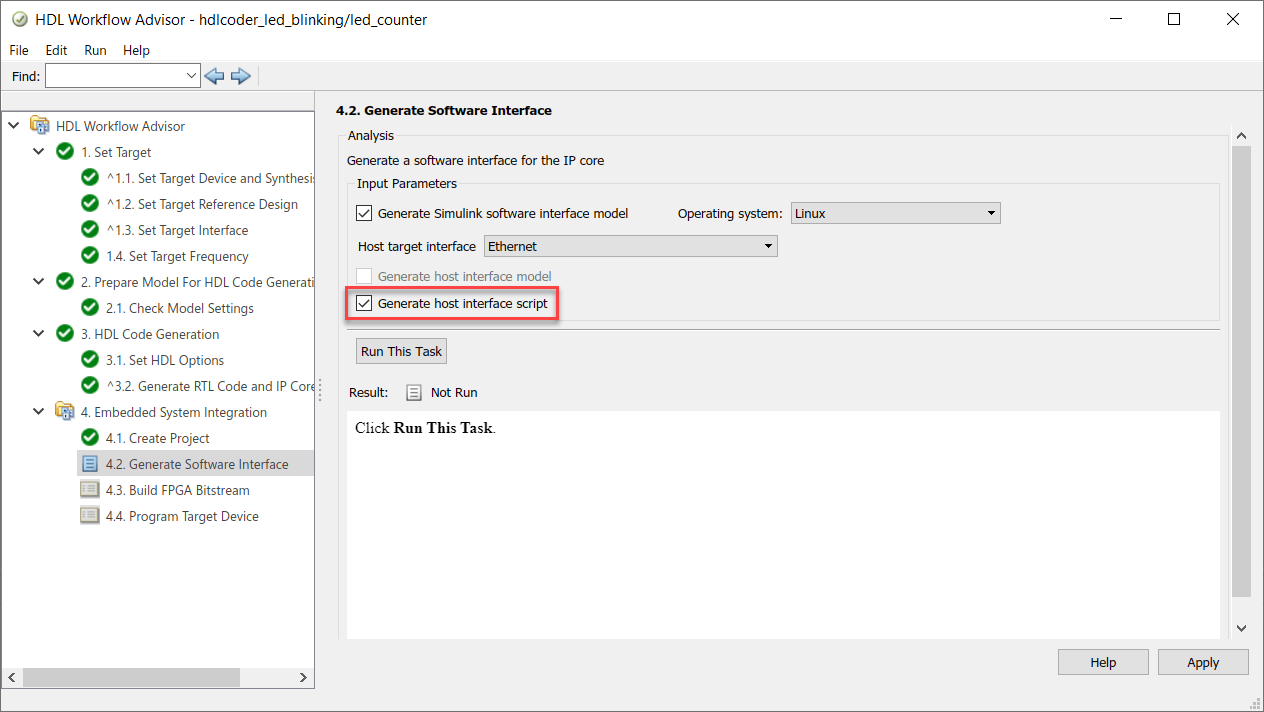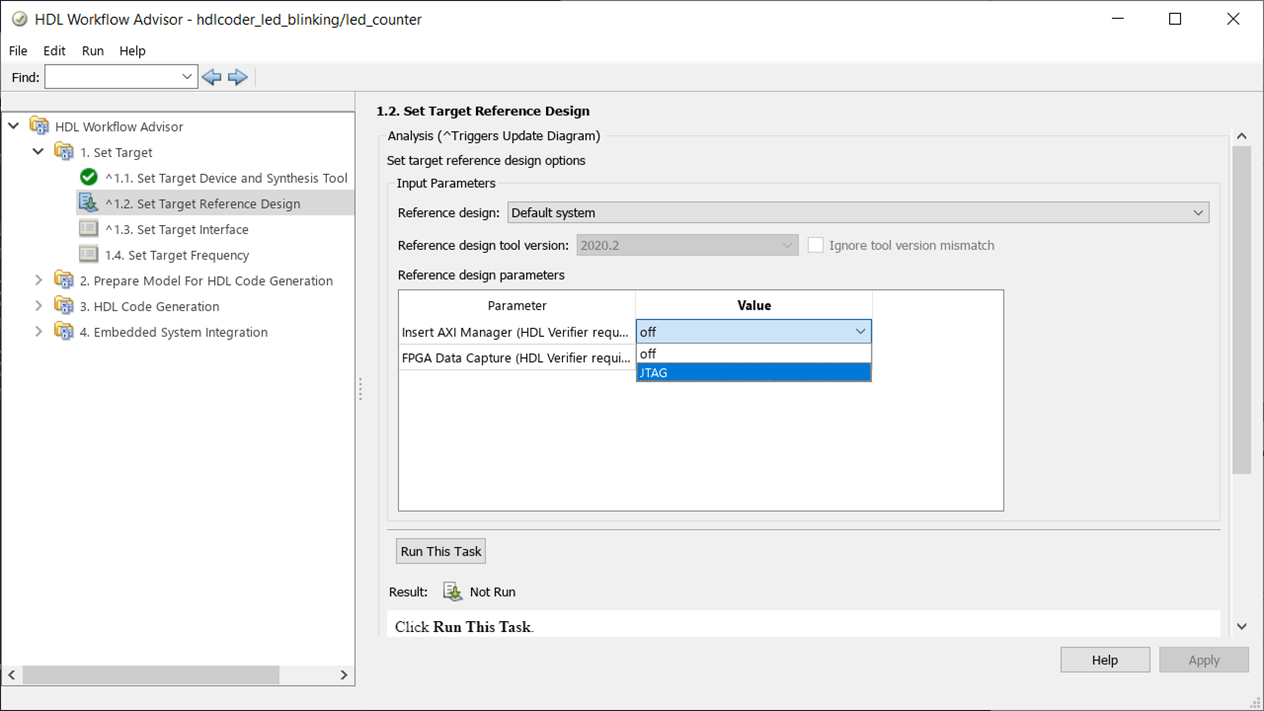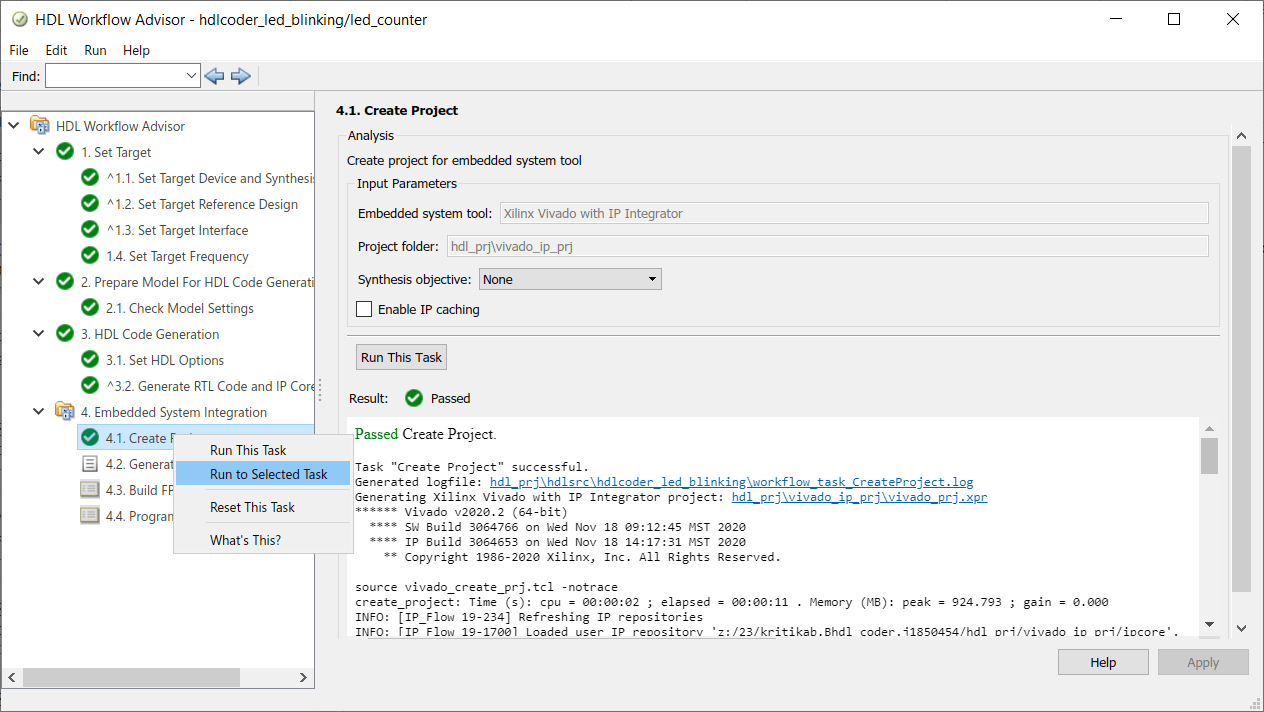Use FPGA I/O to Rapidly Prototype HDL IP Core
Rapidly prototype the HDL IP core by interfacing with your target board over Ethernet or JTAG. Use an Ethernet connection for boards that have an ARM® processor. Use a JTAG connection for boards that do not have an ARM processor.
Prerequisites
A target platform, such as ZedBoard™, where you deploy your software interface model
The latest version of the third-party synthesis tool, such as Xilinx® Vivado®. See HDL Language Support and Supported Third-Party Tools and Hardware. In your MATLAB® session, set the path to that installed synthesis tool by using the
hdlsetuptoolpathfunction.
Ethernet-Based Interface
To use an Ethernet-based connection to your target hardware boards that have an embedded ARM processor, you can either generate a host interface script or create a custom software script. Before setting up the Ethernet-based interface, set up the board’s SD card with the MathWorks® firmware image. To set up the firmware image for your target board:
For Intel® related boards, see Guided Hardware Setup for Intel Boards
For Xilinx related boards, see Guided Hardware Setup for AMD Boards.
Host Interface Script
Set the Host target interface parameter to
Ethernet and select the Generate host
interface script check box. Then, run the Generate
Software Interface task.
The generated MATLAB files are:
gs_modelName_setup.m, which is a setup script that adds the AXI4 slave and AXI4-Stream interfaces. The script also contains DUT port objects that have the port name, direction, data type, and interface mapping information. The script then maps the DUT ports to the corresponding interfaces.gs_modelName_interface.m, which creates a target object, instantiates the setup scriptgs_modelName_setup.m, and then connects to the target hardware. The script then sends read and write commands to the generated HDL IP core.
Customize the Host Interface Script
For rapid prototyping, customize the host interface script or create your own script based on how you modify your original design. Customize the script to specify:
A target object for a different FPGA vendor.
Additional interfaces or configure existing interfaces based on modifications to your original design. HDL Coder™ uses this information to create the IIO drivers to access the HDL IP core.
Additional DUT port objects or remove existing objects based on how you modify your design, and then change the mapping information accordingly.
Input data to write to the DUT ports and output data to read from the ports.
Develop Host Interface Script
You can customize the generated host interface script or create your own host interface script. To create a custom host interface script:
Create an
fpgaobject for the target device and store inhFPGA.hFPGA = fpga("Xilinx")hFPGA = fpga with properties: Vendor: "Xilinx" Interfaces: [0×0 fpgaio.interface.InterfaceBase]To use an Intel target:
hFPGA = fpga("Intel")hFPGA = fpga with properties: Vendor: "Intel" Interfaces: [0×0 fpgaio.interface.InterfaceBase]Configure the AXI interfaces to map the DUT ports in the generated HDL IP core. You can add AXI4 slave and AXI4-Stream interfaces. To add AXI4 slave interfaces, use the
addAXI4SlaveInterfacefunction.addAXI4SlaveInterface(hFPGA, ... ... % Interface properties "InterfaceID", "AXI4-Lite", ... "BaseAddress", 0xA0000000, ... "AddressRange", 0x10000, ... ... % Driver properties "WriteDeviceName", "mwipcore0:mmwr0", ... "ReadDeviceName", "mwipcore0:mmrd0");
To add AXI4-Stream interfaces, use the
addAXI4StreamInterfacefunction.addAXI4StreamInterface(hFPGA, ... ... % Interface properties "InterfaceID", "AXI4-Stream", ... "WriteEnable", true, ... "ReadEnable", true, ... "WriteFrameLength", 1024, ... "ReadFrameLength", 1024, ... ... % Driver properties "WriteDeviceName", "mwipcore0:mm2s0", ... "ReadDeviceName", "mwipcore0:s2mm0");
The interface mapping information that you specified is saved as a property on the
fpgaobject,hFPGA.hFPGA
hFPGA = fpga with properties: Vendor: "Xilinx" Interfaces: [1×2 fpgaio.interface.InterfaceBase]For standalone FPGA boards that do not have an embedded ARM processor, you can create an object, and then use the
aximanagerobject. Then use this object as the driver for theaddAXI4SlaveInterfacefunction. Theaximanagerobject requires the HDL Verifier™ support package for the Intel or Xilinx FPGA boards.% Create an "aximanager" object hAXIMDriver = aximanager("Xilinx"); % Pass it into the addInterface command addAXI4SlaveInterface(hFPGA, ... ... % Interface properties "InterfaceID", "AXI4-Lite", ... "BaseAddress", 0xB0000000, ... "AddressRange", 0x10000, ... ... % Driver properties "WriteDriver", hAXIMDriver, ... "ReadDriver", hAXIMDriver, ... "DriverAddressMode", "Full");
Specify information about the DUT ports in the generated HDL IP core as a port object array by using the
hdlcoder.DUTPortobject. The object represents the ports of your DUT on the target hardware.hPort_h_in1 = hdlcoder.DUTPort("h_in1", ... "Direction", "IN", ... "DataType", numerictype(1,16,10), ... "Dimension", [1 1], ... "IOInterface", "AXI4-Lite", ... "IOInterfaceMapping", "0x100")
hPort_h_in1 = DUTPort with properties: Name: "h_in1" Direction: IN DataType: [1×1 embedded.numerictype] Dimension: [1 1] IOInterface: "AXI4-Lite" IOInterfaceMapping: "0x100"To write to or read from the DUT ports in the generated HDL IP core, map the ports to the AXI interface by using the
mapPortfunction. After you map the ports to the interfaces, this information is saved on thefpgaobject as theInterfacesproperty.mapPort(hFPGA, hPort_h_in1); hFPGA.Interfaces
ans = AXI4Slave with properties: InterfaceID: "AXI4-Lite" BaseAddress: "0xA0000000" AddressRange: "0x10000" WriteDriver: [1×1 fpgaio.driver.AXIMemoryMappedIIOWrite] ReadDriver: [1×1 fpgaio.driver.AXIMemoryMappedIIORead] InputPorts: "h_in1" OutputPorts: [0×0 string]You can also specify this information for ports mapped to AXI4-Stream interfaces.
hPort_x_in_data = hdlcoder.DUTPort("x_in_data", ... "Direction", "IN", ... "DataType", numerictype(1,16,10), ... "Dimension", [1 1], ... "IOInterface", "AXI4-Stream"); hPort_y_out_data = hdlcoder.DUTPort("y_out_data", ... "Direction", "OUT", ... "DataType", numerictype(1,32,20), ... "Dimension", [1 1], ... "IOInterface", "AXI4-Stream");
To write to or read from the DUT ports in the generated HDL IP core, map the ports to the AXI interface by using the
mapPortfunction.After you map the ports to the interfaces, this information is saved on themapPort(hFPGA, [hPort_x_in_data, hPort_y_out_data]);
fpgaobject as theInterfacesproperty.hFPGA
hFPGA = fpga with properties: Vendor: "Xilinx" Interfaces: [1×2 fpgaio.interface.InterfaceBase]hFPGA.Interfaces
ans = AXI4Slave with properties: InterfaceID: "AXI4-Lite" BaseAddress: "0xA0000000" AddressRange: "0x10000" WriteDriver: [1×1 fpgaio.driver.AXIMemoryMappedIIOWrite] ReadDriver: [1×1 fpgaio.driver.AXIMemoryMappedIIORead] InputPorts: "h_in1" OutputPorts: [0×0 string] AXI4Stream with properties: InterfaceID: "AXI4-Stream" WriteEnable: 1 ReadEnable: 1 WriteFrameLength: 1024 ReadFrameLength: 1024 WriteDriver: [1×1 fpgaio.driver.AXIStreamIIOWrite] ReadDriver: [1×1 fpgaio.driver.AXIStreamIIORead] InputPorts: "x_in_data" OutputPorts: "y_out_data"To test the HDL IP core functionality, use the
readPortandwritePortfunctions to write data to or read data from these ports.writePort(hFPGA, "h_in1", 5); writePort(hFPGA, "x_in", sin(linspace(0, 2*pi, 1024))); data = readPort(hFPGA, "y_out");
After you have tested the HDL IP core, you can release the hardware resource associated with the
fpgaobject by using thereleasefunction.release(hFPGA)
For an example on creating a custom interface script and prototyping your design on a target FPGA board over an Ethernet connection, see Prototype Generated IP Core on Hardware using FPGA I/O.
JTAG-Based Interface
For standalone FPGA boards that do not have an embedded ARM processor, you can insert the JTAG AXI Manager IP into your reference
design. Create a script that uses the aximanager object that
connects to the IP over a physical JTAG cable. This script enables read and write
commands to slave memory locations from the MATLAB command line.
To use AXI Manager:
Install the HDL Verifier hardware support packages.
Do not target standalone boards that do not have the
hRD.AXI4SlaveInterfacefunctionality or boards that are based on Xilinx ISE.
Insert JTAG AXI Manager
When you run the IP Core Generation workflow, in the Set
Target > Set Target Reference Design task,
choose Default system for Reference
Design and set Insert AXI Manager (HDL Verifier
required) to JTAG.

To generate the IP Core and create a project with AXI Manager IP, right-click the Create Project task and select Run to Selected Task.

Control the HDL Coder IP Core at the MATLAB Command Line
You can now interact with your target FPGA board by using the JTAG AXI Manager
feature. Create an object by using the aximanager object. Use
the created object as the driver for the addAXI4SlaveInterface function.
% Create an "aximanager" object hAXIMDriver = aximanager("Xilinx"); % Pass it into the addInterface command addAXI4SlaveInterface(hFPGA, ... ... % Interface properties "InterfaceID", "AXI4-Lite", ... "BaseAddress", 0xB0000000, ... "AddressRange", 0x10000, ... ... % Driver properties "WriteDriver", hAXIMDriver, ... "ReadDriver", hAXIMDriver, ... "DriverAddressMode", "Full");
For an example on how to interface with a target board over JTAG, see Debug and Control Generated HDL IP Core by Using JTAG AXI Manager.